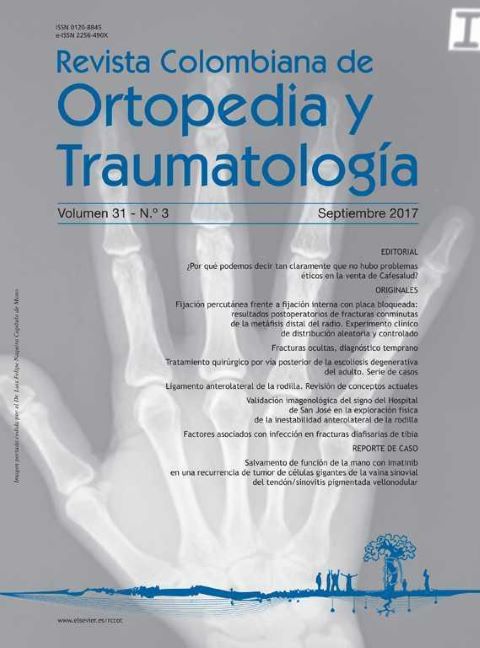Hidden fractures; early diagnosis
DOI:
https://doi.org/10.1016/j.rccot.2017.04.003Keywords:
hidden fractures, early diagnosis, diagnostic errorAbstract
Background: A hidden fracture is defined as that which is not evident radiographically or that in which the initial interpretation fails or the diagnosis is delayed. This diagnosis is always confirmed retrospectively by the use of different imaging tests. The objective of this study is to review the most common sites of these injuries, as well as the age of the patient, concomitant pathologies, type of trauma, and time interval from initial assessment to definitive diagnosis.
Materials and methods: Retrospective, descriptive, series of cases, evidence level IV, with a total of 13 patients, in the period from April 2013 to March 2014, on whom clinical and radiological assessments were initially performed that showed no fractures. An assessment was made using the Mink and Deutsch classification. The definitive diagnosis was made from CT and/or MRI scans.
Results: The study included 5 males and 8 females, with a mean age of 48.3 years., the type of trauma was direct in 11 patients and indirect in 2 patients, the intensity of the trauma was low energy in 5 patients and high energy in 8 patients. The most common sites of fractures were the distal femur and proximal tibia, followed by proximal humerus and proximal femur. The time interval between the initial injury and the final diagnosis was a mean of 7.4 days. According to the classification of Mink and Deutsch classification, 11 patients were type III, and 2 were type II. An MRI scan was the definitive diagnostic method in 92.3% of the cases.
Discussion: The possibility of hidden fractures should always be taken into account in young people with a history of high energy trauma and elderly patients with a history of low-energy trauma and negative radiographs. The affected limb of these patients should be adequately immobilised and supported until the CT and/or MRI scans are completed.
Level of evidence: IV.
Downloads
References
Ahn JM, El-Khoury GY. Occult fractures of extremities. Radiol Clin North Am. 2007;45:561-79. https://doi.org/10.1016/j.rcl.2007.04.008
Boks SS, Vroegindeweij D, Koes BW, Hunink MG, Bierma-Zeinstra SM. Follow-up of occult bone lesions detected at MR imaging: systematic review. Radiology. 2006;238:853-62. https://doi.org/10.1148/radiol.2382050062
Mason BJ, Kier R, Bindleglass DF. Occult fractures of the greater tuberosity of the humerus: radiographic and MR imaging findings. AJR Am J Roentgenol. 1999;172:469-73. https://doi.org/10.2214/ajr.172.2.9930805
Richmond JH, et al. Geriatric hip fractures: Preoperative decision making. J Musculoskelet Med. 2000;17:626-32.
Rizzo PF, Gould ES, Lyden JP, Asnis SE. Diagnosis of occult fractures about the hip. Magnetic resonance imaging compared with bone-scanning. J Bone Joint Surg Am. 1993;75:395-401. https://doi.org/10.2106/00004623-199303000-00011
Vusirikala M, Ramesh N. Easily missed fractures of extremities. Rad Magazine. 2009;35:17-8.
Sahasrabudhe A, Wright V, Cohen P. The occult hip fracture. Tech Orthop. 2004;19:187-96. https://doi.org/10.1097/00013611-200409000-00013
Courtney AC, Wachtel EF, Myers ER, Hayes WC. Age-related reductions in the strength of the femur tested in a fall-loading configuration. J Bone Joint Surg Am. 1995;77:387-95. https://doi.org/10.2106/00004623-199503000-00008
Mo J, et al. Occult fractures of extremities. Radiologic clinics of North America. Iowa: Elsevier; 2007. p. 561-97. https://doi.org/10.1016/j.rcl.2007.04.008
Manzano A. Trauma óseo oculto a los rayos X. Departamento de Radiología del Hospital San Ignacio. Universidad Javeriana Bogotá. Rev Col Radiol. 2009;20:2776-86.
Ahn JM, El-Khoury GY. Role of magnetic resonance imaging in musculoskeletal trauma. Top Magn Reson Imaging. 2007;18:155-68. https://doi.org/10.1097/RMR.0b013e318093e670
Cannon J, Silvestri S, Munro M. Imaging choices in occult hip fracture. J Emerg Med. 2009;37:144-52. 13.
Vela F, Piñeros D. Fracturas ocultas de la cadera. Rev Col Or Tra. 2011;25:64-9. https://doi.org/10.1016/j.jemermed.2007.12.039
Downloads
Published
How to Cite
Issue
Section
License
Copyright (c) 2024 Revista Colombiana de ortopedia y traumatología

This work is licensed under a Creative Commons Attribution 3.0 Unported License.




